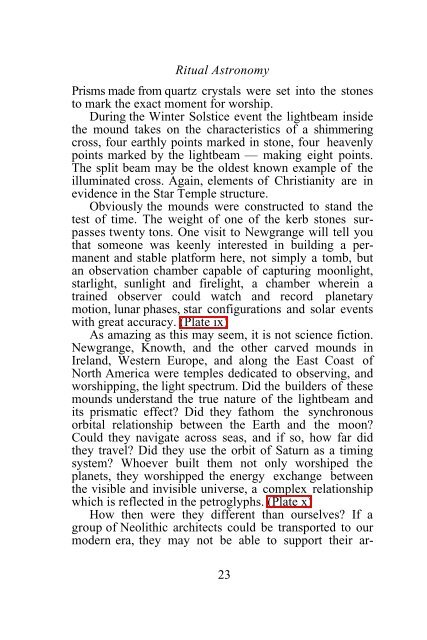001 C&G Trade Paper - The Hank Harrison Portal Gateway
001 C&G Trade Paper - The Hank Harrison Portal Gateway
001 C&G Trade Paper - The Hank Harrison Portal Gateway
You also want an ePaper? Increase the reach of your titles
YUMPU automatically turns print PDFs into web optimized ePapers that Google loves.
Ritual Astronomy<br />
Prisms made from quartz crystals were set into the stones<br />
to mark the exact moment for worship.<br />
During the Winter Solstice event the lightbeam inside<br />
the mound takes on the characteristics of a shimmering<br />
cross, four earthly points marked in stone, four heavenly<br />
points marked by the lightbeam — making eight points.<br />
<strong>The</strong> split beam may be the oldest known example of the<br />
illuminated cross. Again, elements of Christianity are in<br />
evidence in the Star Temple structure.<br />
Obviously the mounds were constructed to stand the<br />
test of time. <strong>The</strong> weight of one of the kerb stones surpasses<br />
twenty tons. One visit to Newgrange will tell you<br />
that someone was keenly interested in building a permanent<br />
and stable platform here, not simply a tomb, but<br />
an observation chamber capable of capturing moonlight,<br />
starlight, sunlight and firelight, a chamber wherein a<br />
trained observer could watch and record planetary<br />
motion, lunar phases, star configurations and solar events<br />
with great accuracy. (Plate ix)<br />
As amazing as this may seem, it is not science fiction.<br />
Newgrange, Knowth, and the other carved mounds in<br />
Ireland, Western Europe, and along the East Coast of<br />
North America were temples dedicated to observing, and<br />
worshipping, the light spectrum. Did the builders of these<br />
mounds understand the true nature of the lightbeam and<br />
its prismatic effect? Did they fathom the synchronous<br />
orbital relationship between the Earth and the moon?<br />
Could they navigate across seas, and if so, how far did<br />
they travel? Did they use the orbit of Saturn as a timing<br />
system? Whoever built them not only worshiped the<br />
planets, they worshipped the energy exchange between<br />
the visible and invisible universe, a complex relationship<br />
which is reflected in the petroglyphs. (Plate x)<br />
How then were they different than ourselves? If a<br />
group of Neolithic architects could be transported to our<br />
modern era, they may not be able to support their ar-<br />
23


